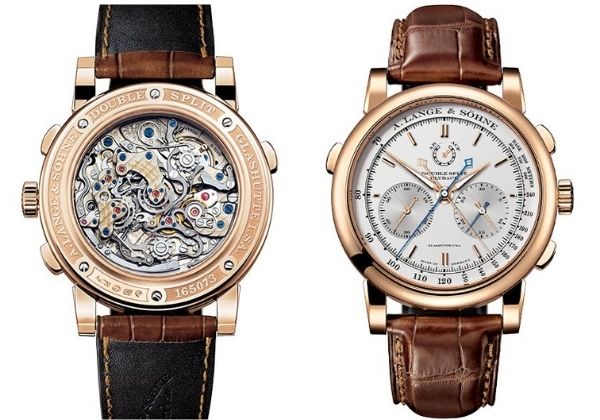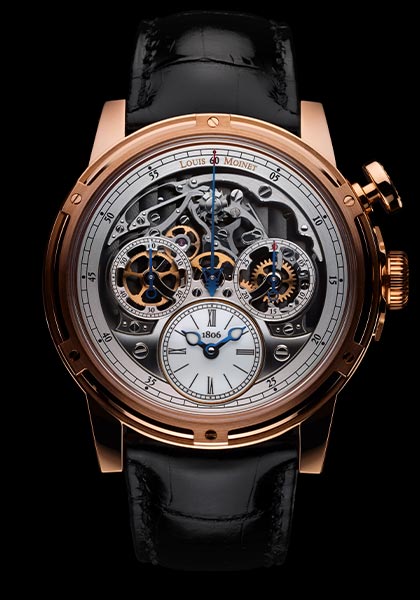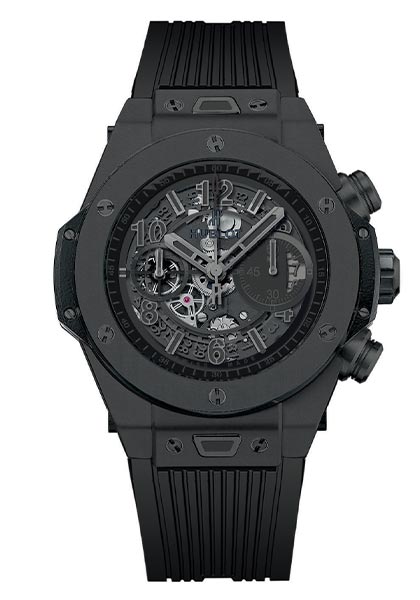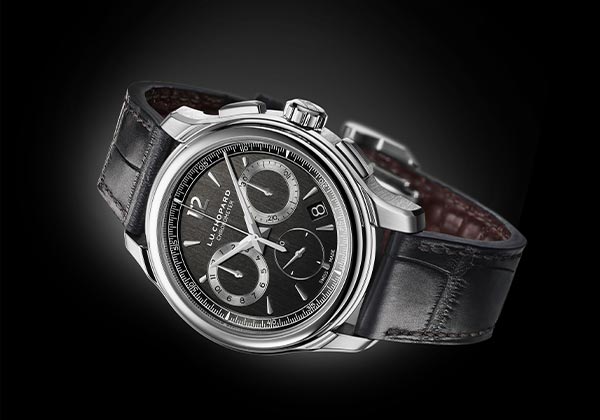De Bethune DB28 Maxichrono
De Bethune’s DB28 Maxichrono came out in 2014, the successor of the 2006 DB21 Maxichrono, and very definitely made its mark. Not least because of its display - the timepiece sports no fewer than five central hands: hours, minutes, and a chronograph with 24-hour, 60-minute and 60-second counters. The Maxichrono also notably features an Absolute Clutch mechanism, which has all the advantages of lateral and vertical clutches whilst also correcting their shortcomings. It features three different types of clutch for three semi-independent systems, controlled by three interdependent column wheels that operate the chronograph’s various counters.

A. Lange & Söhne Double Split and Triple Split
In 2004, the German Manufacture offered a new take on the chronograph, featuring a double rattrapante mechanism. Why? Technically speaking, a single split-seconds mechanism can only record a maximum of 60 seconds of split time. What happens if your split time goes over one minute? The Double Split solves this problem by extending the principle of the split-seconds mechanism to the chronograph minutes.
Fourteen years later, in 2018, the Manufacture repeated the feat with its Triple Split. Controlling three sets of hands, plus a flyback function, and providing the energy required to sustain them, is a work of technical genius. In addition to the complexity involved in the Triple Split construction, A.Lange & Söhne also succeeded in designing a clear, readable dial, despite an impressive total of ten hands and six different graduations.

Louis Moinet Memoris
In 2016, Memoris marked the 200th anniversary of the invention of the chronograph: the Compteur de Tierces completed by Louis Moinet in 1816. Produced by fully independent Ateliers Louis Moinet, the Memoris chronograph’s distinctive feature is that the entire chronograph mechanism is located on the dial side. It otherwise stands in the fine tradition of chronographs, sporting a monopusher and a column wheel. It’s not just a chronograph module atop a base movement, either: the all-new movement has been designed for and around the chronograph.

Hublot Unico Calibre
The Unico Manufacture Chronograph calibre is easily identifiable: it is one of the rare movements to display its column wheel and horizontal clutch chronograph mechanism proudly on the dial side. Introduced under the reference HUB 1240 and set at 4 Hz, it signalled Hublot’s arrival as a manufacture. With an ample thickness of 8mm and equipped with a flyback function, it is automatic – and boasts a power reserve of three full days. One of the calibre’s distinctive features is its removable escapement mounting. This modular aspect facilitates servicing and maintenance of the movement. The escapement is made from silicon; the movement has 330 components. The Unico has an unusual asset when it comes to display possibilities: it can power a small seconds hand at 9 o’clock – or centrally in its GMT version (the HUB 1251 calibre, which features forward and backward change of time band using pushers, plus a day /night indicator). The movement has since been produced in other variants too, such as the HUB 1270, which offers a perpetual calendar.

Chopard L.U.C Calibre 03.03-L
The chronograph is one of the most widespread complications – and one of the most complex, too. The release of a fully manufacture-made chronograph is always a special event, and the L.U.C 03.03-L proved to be no exception. Unveiled in 2007, this chronograph with a decidedly modern design features not only a column wheel mechanism, but also a vertical clutch – designed to limit variations in torque as the chronograph starts and stops – and a highly intuitive, user-friendly reset/flyback pusher function: when in time set mode, the seconds hand of the time mechanism can be set to zero whilst adjusting the minutes hand.

The ‘L’ in the calibre’s name indicates the highest degree of hand finishing available from Chopard. No fewer than four features of this calibre have had patents filed to protect them: unidirectional gears (preventing breakages when winding), pivoting hammers with flexible arms (to avoid an unpleasant click being heard when the pushers are engaged), a ‘Small Second Reset’ (for use with the time set mechanism for perfect accuracy), and a new variable inertia balance wheel, the Variner. Sporting a 60-hour power reserve, the Calibre 03.03-L is COSC certified and a fully integrated movement. Now also produced in QP and Tourbillon versions, it remains the manufacture’s benchmark chronograph.
Parmigiani Fleurier Tonda Chronor
The Tonda Chronor, launched in 2016, was replete with assets: a 5-Hertz movement, two column wheels, a vertical clutch, and a balance wheel held in place with a transverse bridge. Also of note is the atypical choice of material for the movement itself: 18K rose gold. It may not be a technical revolution, but it’s a splendid chronograph, produced by a fully independent Manufacture, with excellent workmanship and finishings.

*On the occasion of GMT Magazine and WorldTempus' 20th anniversary, we have embarked on the ambitious project of summarising the last 20 years in watchmaking in The Millennium Watch Book, a big, beautifully laid out coffee table book. This article is an extract. The Millennium Watch Book is available on www.the-watch-book.com, in French and English, with a 10% discount if you use the following code: WT2021.










